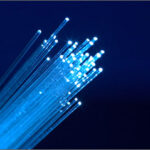Optical fiber is an effective medium for networking because it is flexible and can be bundled as cables. It is especially advantageous for long-distance network  communications, because light propagates through the fiber with little attenuation compared to electrical cables. This allows long distances to be spanned with few or no repeaters. Additionally, the per-channel light signals propagating in the fiber can be easily modulated at 1 Gb/s.
communications, because light propagates through the fiber with little attenuation compared to electrical cables. This allows long distances to be spanned with few or no repeaters. Additionally, the per-channel light signals propagating in the fiber can be easily modulated at 1 Gb/s.
Fiber cable saves space in cable ducts because a single fiber can carry much more data than a single standard data cable. Fiber is also immune to electrical interference; there is no cross-talk between signals in different cables and no pickup of environmental noise. Non-armored fiber cables do not conduct electricity, which makes fiber a good solution for protecting communications equipment located in high voltage environments such as power generation facilities, or metal communication structures prone to lightning strikes. They can also be used in environments where explosive fumes are present, without danger of ignition. Wiretapping is also more difficult compared to electrical connections, and there are concentric dual core fibers that are said to be tap-proof.
Both multi-mode and single-mode fibers are used in communications, with multi-mode fiber used mostly for sho rt distances, up to 550 m (600 yards), and single-mode fiber used for longer distance links. Because of the tighter tolerances required to couple light into and between single-mode fibers (core diameter about 10 micrometers), single-mode transmitters, receivers, amplifiers and other components are generally more expensive than multi-mode components.
rt distances, up to 550 m (600 yards), and single-mode fiber used for longer distance links. Because of the tighter tolerances required to couple light into and between single-mode fibers (core diameter about 10 micrometers), single-mode transmitters, receivers, amplifiers and other components are generally more expensive than multi-mode components.
![]() Click here to go to a page that will put you in touch with us. Answer all of the questions that you can and we will get back to you with a quote.
Click here to go to a page that will put you in touch with us. Answer all of the questions that you can and we will get back to you with a quote.
